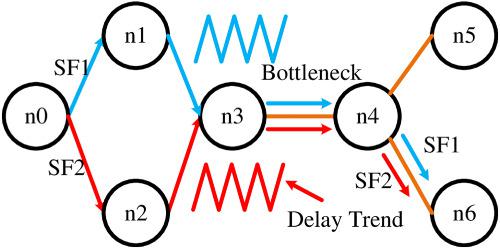当前位置:
X-MOL 学术
›
Int. J. Commun. Syst.
›
论文详情
Our official English website, www.x-mol.net, welcomes your feedback! (Note: you will need to create a separate account there.)
Shared bottleneck detection based on trend line regression for multipath transmission
International Journal of Communication Systems ( IF 2.1 ) Pub Date : 2020-09-25 , DOI: 10.1002/dac.4602 Songyang Zhang 1 , Weimin Lei 1, 2 , Wei Zhang 1 , Yuzhuo zhan 1 , Hao Li 1
International Journal of Communication Systems ( IF 2.1 ) Pub Date : 2020-09-25 , DOI: 10.1002/dac.4602 Songyang Zhang 1 , Weimin Lei 1, 2 , Wei Zhang 1 , Yuzhuo zhan 1 , Hao Li 1
Affiliation

|
Current proposed congestion control algorithms for multipath transmission couple all subflows together to maintain bottleneck fairness by assuming that the subflows traverse a common bottleneck. The coupled form congestion control algorithms restrict the multipath session to gain better throughput in non‐shared bottleneck situation. The throughput of a multipath session following independent rate control is larger than the throughput achieved by coupled form congestion control algorithm. The key point is to find a method to detect whether flows share a common bottleneck. If the subflows of a multipath session are detected out traversing a common bottleneck, the sender could perform coupled congestion control algorithm to guarantee bottleneck fairness and follow independent congestion control algorithm otherwise to improve throughput. Deduced from fluid model of additive increase multiplicative decrease (AIMD) rule, the delay samples can be linearly fitted when the bottleneck link falls into congestion. A delay trend line regression (TR) method is proposed for shared bottleneck detection. The delay slopes in close proximity indicate that the flows traverse the same bottleneck in great probability. Extensive simulations are performed to validate the effectiveness of TR algorithm in shared bottleneck detection. It is further implemented in multipath QUIC Golang codebase to work in collaboration with linked increases algorithm (LIA). Results show a multipath QUIC session with two subflows can gain higher throughput in non‐shared bottleneck situation and is less aggressive in shared bottleneck cases with the implementation of shared bottleneck detection algorithm.
中文翻译:

基于趋势线回归的多径传输共享瓶颈检测
当前提出的用于多径传输的拥塞控制算法将所有子流耦合在一起,以通过假设子流横贯公共瓶颈来保持瓶颈公平性。耦合形式的拥塞控制算法限制了多路径会话,以在非共享瓶颈情况下获得更好的吞吐量。独立速率控制后的多路径会话的吞吐量大于耦合形式拥塞控制算法所实现的吞吐量。关键是找到一种方法来检测流是否共享一个共同的瓶颈。如果检测到遍历常见瓶颈的多路径会话的子流,则发送方可以执行耦合的拥塞控制算法以确保瓶颈公平性,并遵循独立的拥塞控制算法来提高吞吐量。根据加减乘积法(AIMD)规则的流体模型推导,当瓶颈链路陷入拥塞时,可以线性拟合延迟样本。提出了一种延迟趋势线回归(TR)方法用于共享瓶颈检测。延迟斜率非常接近,表明流量极有可能穿越相同的瓶颈。进行了广泛的仿真,以验证TR算法在共享瓶颈检测中的有效性。它在多路径QUIC Golang代码库中进一步实现,以与链接增加算法(LIA)协同工作。结果显示,具有两个子流的多路径QUIC会话在非共享瓶颈的情况下可以获得更高的吞吐量,而在共享瓶颈情况下,通过实现共享瓶颈检测算法,它的攻击性较小。
更新日期:2020-11-09
中文翻译:

基于趋势线回归的多径传输共享瓶颈检测
当前提出的用于多径传输的拥塞控制算法将所有子流耦合在一起,以通过假设子流横贯公共瓶颈来保持瓶颈公平性。耦合形式的拥塞控制算法限制了多路径会话,以在非共享瓶颈情况下获得更好的吞吐量。独立速率控制后的多路径会话的吞吐量大于耦合形式拥塞控制算法所实现的吞吐量。关键是找到一种方法来检测流是否共享一个共同的瓶颈。如果检测到遍历常见瓶颈的多路径会话的子流,则发送方可以执行耦合的拥塞控制算法以确保瓶颈公平性,并遵循独立的拥塞控制算法来提高吞吐量。根据加减乘积法(AIMD)规则的流体模型推导,当瓶颈链路陷入拥塞时,可以线性拟合延迟样本。提出了一种延迟趋势线回归(TR)方法用于共享瓶颈检测。延迟斜率非常接近,表明流量极有可能穿越相同的瓶颈。进行了广泛的仿真,以验证TR算法在共享瓶颈检测中的有效性。它在多路径QUIC Golang代码库中进一步实现,以与链接增加算法(LIA)协同工作。结果显示,具有两个子流的多路径QUIC会话在非共享瓶颈的情况下可以获得更高的吞吐量,而在共享瓶颈情况下,通过实现共享瓶颈检测算法,它的攻击性较小。



























 京公网安备 11010802027423号
京公网安备 11010802027423号